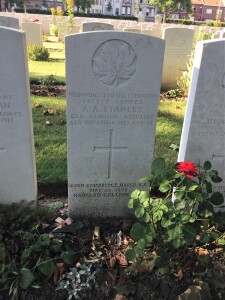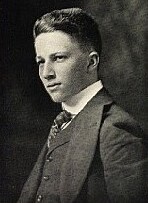6 November (1917)…

Gunner Wainwright Merrill
6 November 1917
Ypres Reservoir Cemetery, Belgium
(P. Ferguson image, August 2018)
Gunner Wainwright Merrill served as Arthur Ashton Stanley
343939
6th Siege Battery
Canadian Garrison Artillery
Though the Wainwright Merrill story can be found elsewhere on the internet (See Lauren D. Sphon: The Harvard Crimson) he is chosen here for a simple reflection on my part….a parent’s walk to their child’s graveside at Ypres Reservoir Cemetery I.I.91.
Born in Cambridge, Massachusetts, U.S.A., Wainwright was a student at Harvard College but chose to leave and signed on, giving a false birthdate as he was underage, with the Canadian Expeditionary Force [CEF]. He was the son of Samuel, member of the editorial staff of the Boston Globe and the late Estelle Merrill (also of the Boston Globe and a charter member of the New England Woman’s Press Association)…Wainwright’s enlistment into the C.E.F. was not met with his father’s approval. The surname Stanley appears to have been adopted from a cousin. At the time of Wainwright’s enlistment in Montreal, Quebec he recorded his address as the St. James Hotel. Wainwright arrived on the Western Front 17 October 1917 and died of his wounds 6 November 1917 at No. 6 Field Ambulance. His injuries were caused at noon when the 6th Siege Battery was heavily shelled by 5.9 German guns and the cellar billet in which Wainwright was located was blown in on top of him.
Ypres Reservoir Cemetery was originally called Cemetery North of the Prison and was started in October 1915 and in use throughout the war. After the armistice the cemetery was enlarged when remains were re-interred here from around the Ypres Salient and concentrated from smaller burial grounds…Ypres Reservoir South Cemetery (Prison Cemetery No. 1) and Ypres Reservoir Middle Cemetery (Prison Cemetery No. 2). The use of Prison reflecting the location of the cemeteries near to the city’s lockup. Today there are 2,693 Commonwealth burials on site of which 1,034 personnel are not identified.
My interest in Gunner Merrill, this day, relates to a letter received by the Office Commanding, Canadian War Graves Detachment, Ypres, Belgium (and included in Wainwright’s service record) from his father Samuel Merrill who visited the grave sometime prior to 20 August 1920. Within Samuel’s letter he notes he originally requested his son’s remains be re-buried at an American Cemetery near Paris, France. However after seeing where his son was interred and perhaps influenced by all he saw on his pilgrimage Samuel wrote…having visited his grave I have concluded that it would be much better to let his body remain where it lies…
Samuel Merrill also makes mention of the original wooden cross marking the grave that had a bullet hole below the inscription. Wainwright Merrill was 19 years of age and was the author of A College Man in Khaki published in 1918. A number of books, in Wainwright Merrill’s memory, are located at Harvard College Library Funds presented through the Wainwright Merrill Memorial Fund established in 1986.
Wainwright Merrill would have been a Harvard graduate of the Class of 1919.
This Day
6 November 1917
1,907 Fatalities
Source: Commonwealth War Graves Commission


Comments